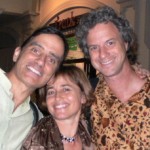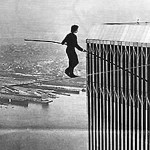Man On Wire
So it begins: the 10-hour flight to Tokyo; the 5-hour layover amid the cutting-edge consumerism of the Narita Airport mall, where I escaped the tsunami of irresistible electronic temptations by falling into the pummeling embrace of a coin-operated massage chair; and then the surreal, seemingly endless final leg: 7 hours on to Krung Thep, where the gray cityscape belied the warmth and comfort of Jock and Annie’s eternal abode. Arrived under tumultuous rain, the taxi throwing up sheets of water as it pulled off Rama IV Road and onto Soi 26.

Still amazing, that in a total of 27 hours I was able to transport myself from door to door: from my Oakland, California abode to this Bangkok oasis, the much-loved “Wooden House” that has sheltered so many kindred nomads.
During last year’s visit to Asia, I returned to Kathmandu for the first time in five years – and vowed to make Nepal a regular part of my life once again. I’m keeping my word. After a long weekend with my great friends Jock and Annie – and a road trip to Chaloem Rattanakosin National Park, with its famous cave-dwelling barking toads– I’ll be flying on to Kathmandu. From which point, for some reason, writing this blog seems so much more… essential.
One final note. Just before leaving the Bay Area, a friend took me to see one of the most inspiring and unforgettable films I’ve ever seen. Man on Wire instantly took a place in my all-time Top 20 Films. Beautiful, audacious, maddening and jaw-dropping, this documentary says just about everything there is to say about risking everything for one’s art. Don’t miss it.
And hey… while composing this entry, I came across this cool website, definitely worth a look: “Walking as Art.”


 I don’t know about all that
I don’t know about all that.jpg) up for paragliding lessons, we have to content ourselves with high-altitude hikes in the Sierra and quasi-weightless dips into mountain hot springs and alpine lakes.
up for paragliding lessons, we have to content ourselves with high-altitude hikes in the Sierra and quasi-weightless dips into mountain hot springs and alpine lakes. .jpg)


 3rd-largest statue of Jesus in the world (right up there with Rio and Santiago).
3rd-largest statue of Jesus in the world (right up there with Rio and Santiago).


 On March 18th
On March 18th transcendence—of the human race. He left us with scores of wonderful books, food for thought to nourish generations to come, and the most useful tool ever placed into human hands: the communications satellite. Farewell, my friend. What we owe you is beyond evaluation.
transcendence—of the human race. He left us with scores of wonderful books, food for thought to nourish generations to come, and the most useful tool ever placed into human hands: the communications satellite. Farewell, my friend. What we owe you is beyond evaluation.
 this be? Am I getting lazy? Have I lost my spark? Wasn’t it Yours Truly who created the very first international blog, in 1993/1994, with my
this be? Am I getting lazy? Have I lost my spark? Wasn’t it Yours Truly who created the very first international blog, in 1993/1994, with my  Truth is, I prefer writing live blogs
Truth is, I prefer writing live blogs become visceral reality. Before my visit to Tassie, the only Devil I’d seen was Taz, the voracious dervish of Bugs Bunny fame. Never dreamed I’d meet—and come to adore—the actual item.
become visceral reality. Before my visit to Tassie, the only Devil I’d seen was Taz, the voracious dervish of Bugs Bunny fame. Never dreamed I’d meet—and come to adore—the actual item. 
 Meanwhile, let me recommend a book I’m reading. She sort of came out of nowhere — writing, directing, and starring in the effervescent indy film,
Meanwhile, let me recommend a book I’m reading. She sort of came out of nowhere — writing, directing, and starring in the effervescent indy film, .jpg) as well. I’m halfway through her first book,
as well. I’m halfway through her first book,  The sage-green and pale brown bills – worth about 16 cents – show the sunken-eyed, scowling monarch glancing off to the right, as if wary even of the portrait artist (as well he might have been). On the new bills, the portrait of the king is printed over with a bouquet of red rhododendrons, the national flower. But locals delight in holding the revamped bill to the light, proving that the monarch is still hiding behind the scenes.
The sage-green and pale brown bills – worth about 16 cents – show the sunken-eyed, scowling monarch glancing off to the right, as if wary even of the portrait artist (as well he might have been). On the new bills, the portrait of the king is printed over with a bouquet of red rhododendrons, the national flower. But locals delight in holding the revamped bill to the light, proving that the monarch is still hiding behind the scenes. 

 electricity now, and motorcycles are parked outside some of the shops. Aquifers are channeled through brass nozzles (instead of carved naga spouts), and gush onto cement platforms. There are more schools, and trucks carry 50 kg sacks of produce to the markets in Asan and Kupondole. But it’s the little things that get me: men taking pictures of local pujas with their cell phones; writing pads emblazoned with Spider-man; porches decorated with glittering CDs, which dangle and turn in the breeze.
electricity now, and motorcycles are parked outside some of the shops. Aquifers are channeled through brass nozzles (instead of carved naga spouts), and gush onto cement platforms. There are more schools, and trucks carry 50 kg sacks of produce to the markets in Asan and Kupondole. But it’s the little things that get me: men taking pictures of local pujas with their cell phones; writing pads emblazoned with Spider-man; porches decorated with glittering CDs, which dangle and turn in the breeze. 
 unrecognizably, between the mid-1980’s and late 1990’s. Most of the changes were for the worse. But the process of degradation seems to have reached a plateau; aside from the political chaos, and the portrait of the unsmiling King Gyanendra on the newly minted rupee notes, the Himalayan capital is not very different from my last visit. Beyond the brick wall of Chrissie’s little garden, a street vendor totes a cloud of toy balloons; they pass like a giant white-and-pink rhododendron bloom. The air is filled with dust and butterflies, scooters bounce down pitted dirt lanes, the eyes of Buddha gleam from the gilt temple harnika of Swayambhu, and the ground-level shops in Asantole and Indrachowk overflow with bangles and incense, prayer flags and goat heads, spices and rope, silver cups, sarees, yak wool sweaters. I’m overflowing, too. It’s good to be home.
unrecognizably, between the mid-1980’s and late 1990’s. Most of the changes were for the worse. But the process of degradation seems to have reached a plateau; aside from the political chaos, and the portrait of the unsmiling King Gyanendra on the newly minted rupee notes, the Himalayan capital is not very different from my last visit. Beyond the brick wall of Chrissie’s little garden, a street vendor totes a cloud of toy balloons; they pass like a giant white-and-pink rhododendron bloom. The air is filled with dust and butterflies, scooters bounce down pitted dirt lanes, the eyes of Buddha gleam from the gilt temple harnika of Swayambhu, and the ground-level shops in Asantole and Indrachowk overflow with bangles and incense, prayer flags and goat heads, spices and rope, silver cups, sarees, yak wool sweaters. I’m overflowing, too. It’s good to be home.  Arrived in Nepal in mid-October
Arrived in Nepal in mid-October the food, she would tire quickly, the heat would be too much, the dust, the crowds, India. Wrong. We rode rickshaws into Delhi’s mobbed Old City, and an elephant up to Amber Fort. She developed a taste for papdam, masala dosa, and fresh lemon sodas. Her health was perfect, and she kept up with a punishing schedule that included hours – too many — in a bulbous Ambassador cab.
the food, she would tire quickly, the heat would be too much, the dust, the crowds, India. Wrong. We rode rickshaws into Delhi’s mobbed Old City, and an elephant up to Amber Fort. She developed a taste for papdam, masala dosa, and fresh lemon sodas. Her health was perfect, and she kept up with a punishing schedule that included hours – too many — in a bulbous Ambassador cab.  It was the most time I’d spent with my Mom
It was the most time I’d spent with my Mom  to do, so many friends to see, so little time. I suspected when I planned this trip that 18 days was going to be a little too long — or way too short. What was I thinking? Returning to Nepal is like falling back into a familiar embrace. Life here may be tough, but it’s life on a human scale. From this perspective, there an amazing awareness of the many levels that surround us – from the sacred snake-gods in the subterranean pools to the toxin-choked Bagmati River; from the ravens screeching from the tree-tops to the eyes of Buddha atop the Boudha dome. On every level, every level. That’s why I love Nepal. That’s why, even after five years, I call it home.
to do, so many friends to see, so little time. I suspected when I planned this trip that 18 days was going to be a little too long — or way too short. What was I thinking? Returning to Nepal is like falling back into a familiar embrace. Life here may be tough, but it’s life on a human scale. From this perspective, there an amazing awareness of the many levels that surround us – from the sacred snake-gods in the subterranean pools to the toxin-choked Bagmati River; from the ravens screeching from the tree-tops to the eyes of Buddha atop the Boudha dome. On every level, every level. That’s why I love Nepal. That’s why, even after five years, I call it home. 



